Finissage 11 December
16:00-17:00
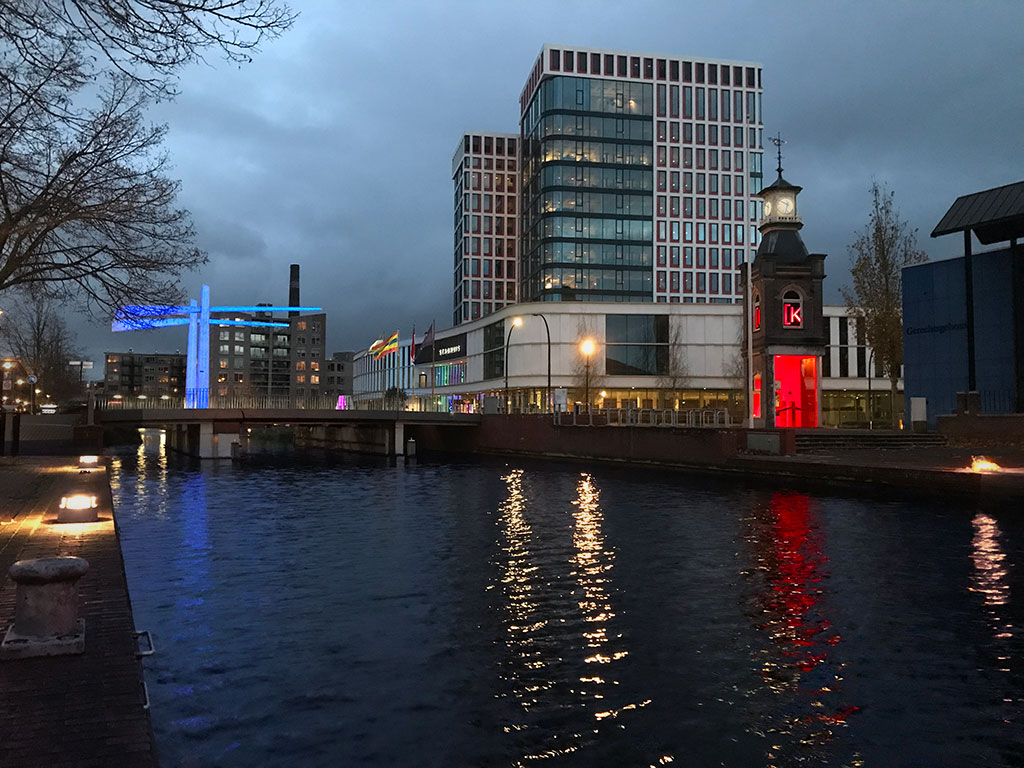
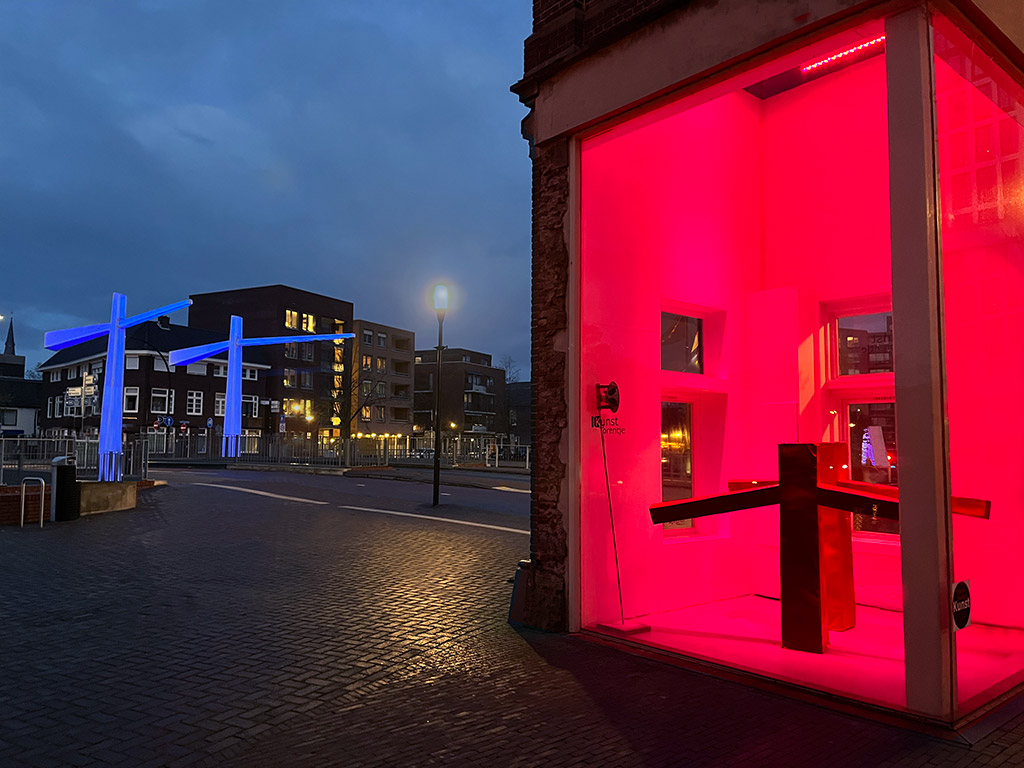
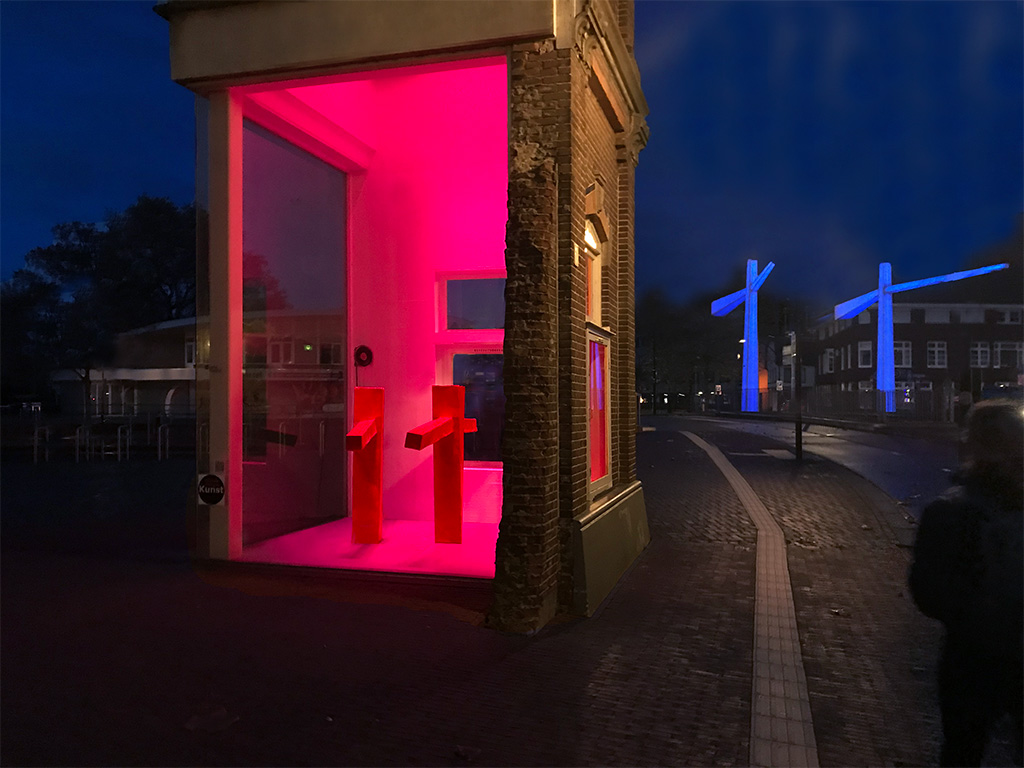
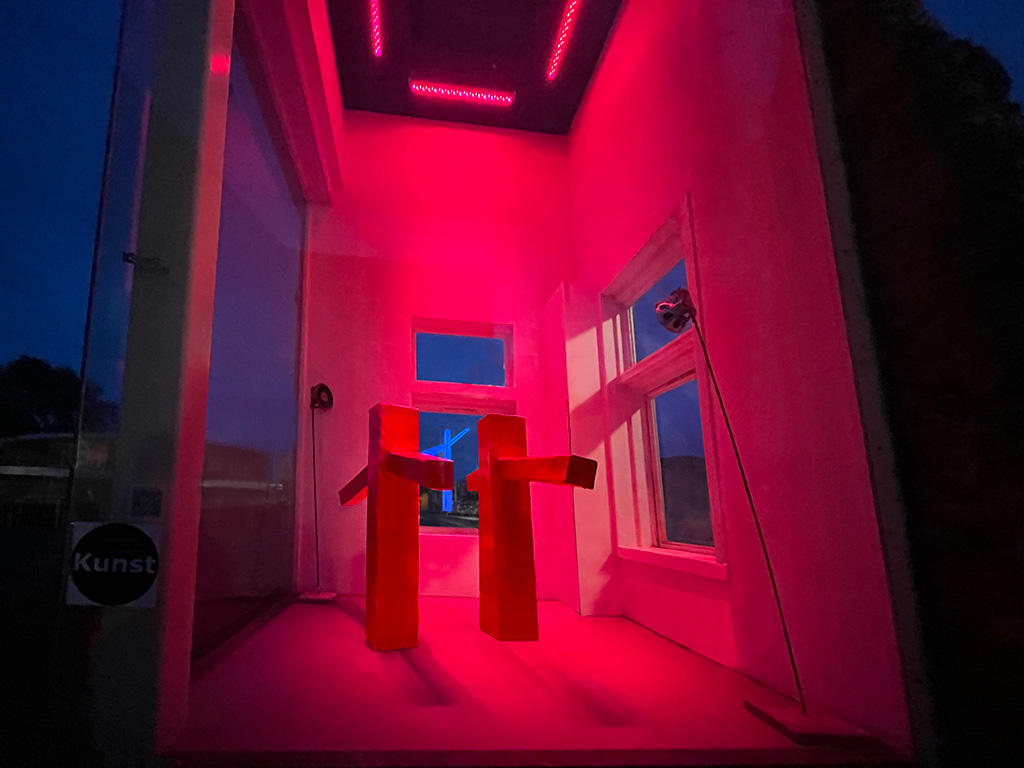
Art-Butchering Performance
The Death
I will be killing something that I love with all my heart—my art, it feels wrong somehow that I will annul my artwork. Because I will make it physically disappear. On the other hand, I did create it, so I can also do that. But it does not feel pleasant. It moves me. Will I be able to do it?
Am I sacrificing a living being as a butcher does? No. But, yes, if you think that art has a soul too. That art has the ability to move us. Because art can bring us many things, beauty, joy, comfort, spirituality, experiment, and more.
But, I think I can do it if I am not thinking of that part while butchering the artwork. But purely about the fact that I will be bringing it back to the essentials.
A phrase from the burial service: We, therefore, commit this body to the ground, earth to earth, ashes to ashes, dust to dust; in sure and certain hope of the Resurrection to eternal life.
In art, as an artist, there is no sure and certain hope. We artists either continue or give up (creating art). For a future ofArt, we have to continue to create art, with or without the sales, the fame, and despite the often external humiliation and the internal doubt, it can bring.
I think the joy might lie only in the flow of creating the art. And when, during the Art-Butchering Performance, the red bridge artwork is being canceled, by this art act, something else, whatever it is, is inevitably being created.
A Body of Work
In art jargon, when we say a body of work, we mean the art-production of a single artist. Art is the body. I, the performer, have a body. The Bridge-Sculpture looks like two bodies, standing across from each other, wide armed. Open. Ready to hug you. Red, the color of love. They are a form of love, made with love. And now these bodies will be butchered.
It feels difficult for me since I am not the type of artist who destroys. I like to create. Bring something good, positive. Build bridges (now also literally). And still, I do this. What does it mean?
The title of this humanize artwork is, Questioning my Significance. The title came first from this particular artwork. And is existential.
What does this artwork mean? Emotionally or monetary? What do I as an artist mean? How important or valuable am I? How do we measure this? Power? Fame? Money? Does a work of art to be ruled of value need to have these aspects?
Maybe, if one person loves the work (or me for that matter), the artwork is worthy, I am then worthy? Or is merely beingenough? A creation of God. Be it then a human or a work of art?
And it is an artwork since; an artist has created it; made in a public art space; with a concept, and it has its particular form and color. Or simply it is; it exists.
A better life
However, the Art-Butchering Performance at the end of its exhibition period will deconstruct the existing artwork back to its basic materials.—Paper, iron, and plastic.
If we look, for example, at a painting at an art auction, what does the art collector exactly pay for? We could say it is canvas and paint, not a lot of materials, and in themselves not super expensive. But it is more, of course, it is amongst others what the artist has done with these elements. The reputation of the artist. And the appraisal the artwork received is what the work of art makes so valuable.
But, has a work of art the right to exist if it is not deemed valuable by the artist or the public? Or worse when it is not even visible to the public?
Maybe there is a form of self-destruction involved in this particular Art-Butchering Performance. Or perhaps it is a cry for a new life, a better life. To strip it down to the elemental ingredients. To then be able to rebuild it, bettering it, improving it. With love coming from the inside to the outside. And not the other way around.
The Art-Butchering Performance is a destruction of the construction. With the question: What is my/its/Arts significance? Aren’t most real valuable things vulnerable and temporary anyway? Like life? We have life. And we will lose a life.
Or is it a kind of cleansing? To force a new start? Or to destroy a part of history? It is a bit dark. So the butchering of the red artwork does relate to that; Red, powerful, love, skin, emotion, meat, the body. And all this radically transparent in plain public.
What is going to be butchered?
A human-size bridge sculpture. The red artwork consists of two pillars with trusses. Which look like 2 people standing across of each other with open arms.
The name of the bridge sculpture (and of the solo exhibition) is: Questioning my Significance.
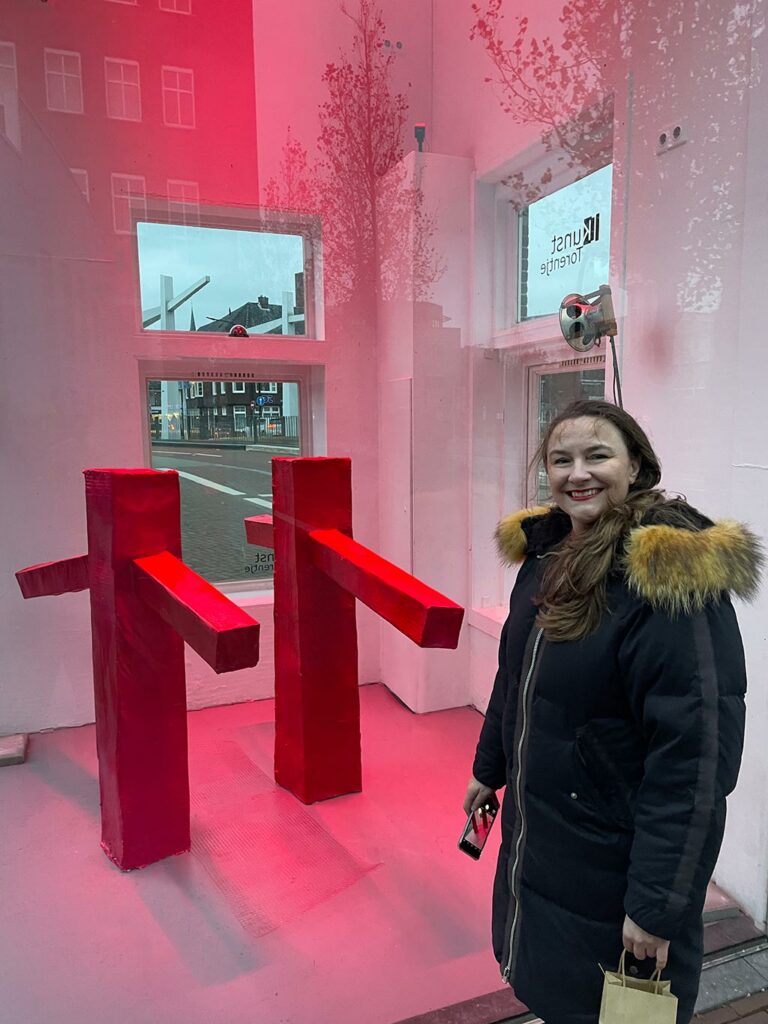
Questioning my Significance
I want to connect with my bridges. My Bridge-Performances are an artificial and safe way for me to do this. Just like a bridge is artificially created to bridge a possible obstacle, such as water, and to connect people and locations.
Temporary
Temporary encounters play an important role in my work. Apparent contrasts I find curious, such as connection and letting go. Intimacy and distance. Home and disruption. Connection and broken connections.
I work interdisciplinary and explore installation settings in exhibitions, through which I seek to connect and communicate with the public. Kunst-Torentje is a transparant semi-public art space. He I could work in my own bubble, yet totally visible to the audience as in an aquarium.
In my art practice, I think about making connections. Not as an end in itself. But more as a starting point in never-ending lessons in improving communication, setting boundaries, and staying or becoming yourself. In short, self-improvement through and in temporary communal constructions.
SCRIPT
11 DECEMBER 16:00
The Art-Butchering performance will consist of 3 acts:
– The slaughter of the work of art.
– Showing the slaughtered elements.
– And the auctioning of these parts.

Act 1/Interior:
Kim Engelen will wear a butcher’s apron and gloves. She will lay out a white cloth and display her tools on it; A small hacksaw, a box cutter, hand cutters, scissors and one seal bag.
First Kim Engelen will cut the “skin” off the artwork with a box cutter. This is the red-painted papier-mâché separating parts from the bridge skeleton. She does this with both parts of the sculpture. —This paper will be 1 package.
Then she will cut the tie-wraps. And a separate bundle is also formed from these parts. These plastic parts are collected in a transparent sealable fresh-keeping bag.
And finally she’s going to cut off the “arms”. And cuts the bird netting into small parts. She also bundles these parts together.
Short conversations will be heard through speakers throughout the slaughter. These are the interviews that Kim Engelen (earlier on November 1) conducted with people next to the Egbert Gorter bridge in Almelo.
Interviews around the Egbert Gorter Bridge in Almelo
Act 2/Exterior
Miss Almelo, a local pretty young girl in waitress clothes (white blouse, black pencil skirt, and white gloves) is going to show the three packages to the public. And then place them on 3 wooden white pedestals, of 1 meter high.
Act 3
Then an auctioneer will trade the 3 elemental pieces.
In the audience are 3 actors who make it work and they will make sure there is bidding going on. And in each round a different actor wins the package. Unless the real audience competes. In that case, the actors let it pass to the real audience. Prices start very low from €1 so that the public is more likely to participate.
The auctioneer ends the auction.
End of performance.
Welcome
The exhibition period is from 6-11 until 11-12 2021.
The Art-Butchering takes place on 11 December 2021, 16:00

Address
Egbert Gorterstraat 5
7607 GB Almelo, Netherlands
The Kunst-Torentje is a special exhibition space in the public space. Located between the Egbert Gorter bridge and the central station.
Thank you
To make this Art-Butchering Performance a reality I had the help of many people, who I am very thankful of!
The minimalistic-looking white 3 pedestals where handmade by Steven de Jong from De Houten Leeuw. The audio was taken care of by Kees van der Knaap. With whom I also recorded the short talks which were audible in the first act (when I was butchering the art-work) and in the final part when the auctioneer was trading the elements. Then I want to super joyfully thank Marcel Löwik from Microform B.V. who sponsored the invitation-postcards. Thank you to the audience for coming! With this act you support me, and in general art & culture. And I warmheartedly appreciate you all for this.
sponsoring
Kim Engelen Art News
Do you like this type of art and this kind of information?
Receive it directly in your inbox, by filling in your email.

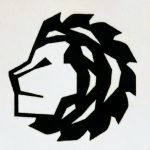
Yes, it is a strong move. There is something very powerful and even creative in destroying an artwork.
We create a kind of freedom from the preciousness, a freedom from having to keep it.
Perhaps a freedom from continuing to be its mother.
I like the angle of reducing it back to it’s essential elements…
So your butchering is also references our own life cycles.
The sculpture was made inside that little glass box for all to see and it is the perfect finish to dismember it also within the box, publicly.
To bring out the elements for auction on the plinths has echos of the priestly rituals of bringing the animal’s blood and parts to the alter as an offering.
Yet it is an auction, so it is also a comment on what we really worship these days, money!
A very strong piece Kim!